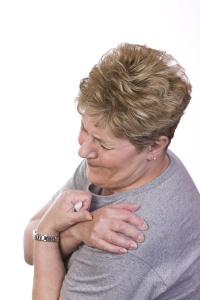Shoulder impingement is a condition where there is pain in the shoulder just underneath the bony roof (acromion) with forward flexion, internal rotation or sideward movement of the arm (abduction).
This is so, because the supraspinatus tendon and the subacromial bursa get trapped between the upper humerus bone and the acromion of the shoulder blade.
Patients who have this kind of problem have it because there is a variation of the angle that the acromion forms, with which they were born (acromion type I, II or III). This leads to a narrowing of the space between the acromion and the rotator cuff within the shoulder with type II and III, while type I is normal.
Rotator cuff tendinitis and shoulder bursitis
Things are just a bit more narrow under the acromion and this can lead to an irritation and inflammation of the rotator cuff (rotator cuff tendinitis). The other structure that often suffers inflammation is the bursal sac (shoulder bursitis) underneath the acromion. Repetitive movements with the upper arm at work or with sports activities can then bring this on easier than in someone where the shoulder has lots of space inside.
X-rays will show whether the acromion is a type I , II or III type where type I is normal and type III is curved down thus impinging the supraspinatus tendon. An MRI scan can show more details of the space, the supraspinatus and biceps tendon and the state of the subacromial bursa.
Impingement test
If the impingement test is positive during an orthopedic examination and the MRI scan confirms that, the orthopedic surgeon might offer shoulder decompression surgery.
To create space for the tendons and the rotator cuff mechanism the physician does the following procedure. The surgeon has to cut off the outside part of the clavicle (the distal clavicle) together with the AC joint. In addition, the surgeon also removes a wedge from the acromion. Often the subacromial bursa has to be removed as well. Following this procedure the patient usually feels better. However, the shoulder range of motion is usually 25% to 40% less than normal. In other words, there often is a trade off for controlling the shoulder pain. It is a certain lack of shoulder range of motion as a result of shoulder surgery (Ref. 1).
Reference
1. ABC of rheumatology, second edition, edited by Michael L. Snaith , M.D., BMJ Books, 1999.
2. The Merck Manual, 7th edition, by M. H. Beers et al., Whitehouse Station, N.J., 1999.
3. Goldman: Cecil Textbook of Medicine, 21st ed.(©2000)W.B.Saunders
4. Ferri: Ferri’s Clinical Advisor: Instant Diagnosis and Treatment, 2004 ed., Copyright © 2004 Mosby, Inc.
5. Rakel: Conn’s Current Therapy 2004, 56th ed., Copyright © 2004 Elsevier
6. Wheeless’ Textbook of Orthopaedics: http://www.wheelessonline.com/ Several topics can be found under this link by entering the term you search for.
7. Suzanne Somers: “Breakthrough” Eight Steps to Wellness– Life-altering Secrets from Today’s Cutting-edge Doctors”, Crown Publishers, 2008







